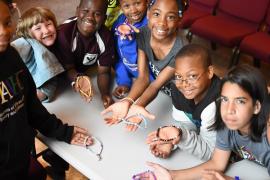My mother crochets. Over tea in restaurants. In line at the airport. At the movies. If you can breathe there, my mom can crochet there. She crochets for friends, family, and perfect strangers. Literally. At the end of one flight to San Francisco, I watched her give a newly knotted Christmas stocking to the woman sitting next to her simply because the woman had said she liked it. That’s my mom in a nutshell. Or in a granny square. She’s eccentric, generous, and has mad skills for most things she sets her mind to. She was perseverant ages before it was trendy to have grit. And long before it was popular, she raised me to be inclusive and gender transcendent. Which is just another way of saying that she insisted on treating other people with fairness and kindness.
Ridicule and Relationships
When I say “long before it was popular,” I am not using a figure of speech. One of the first things my mother crocheted for me was a poncho. In 1975, nothing brought the wrath of the first-grade bullies (boys and girls alike) faster than a boy (me) wearing a poncho, let alone a green poncho with red trim. My mother’s naïve counsel to “Tell anyone who makes fun of you that men were actually the first ones to wear ponchos” demonstrated how pitifully distanced she was from elementary school culture. Or any culture where genders had dress codes. Which is every mainstream culture. So, to say that I was unpopular in first grade is akin to saying Hurricane Maria rained on Puerto Rico.
When I tearfully begged not to wear the poncho, my mother was resolute, explaining that if someone had a problem with my wearing gender-atypical clothing, it was their problem. Even as a seven-year-old, I knew she was right. But it sure didn’t feel like anyone’s problem but mine. I was the one being called a pussy, a sissy, a fembot (look it up), a douche, and — of course — a girl. It all hurt, but I endured, eventually outgrowing the poncho and emerging both resentful and resilient.
Fast-forward 25 years. I was standing with my wife and four-year-old son in front of Puddle Jumpers, the children’s clothing boutique in downtown Exeter, New Hampshire. He was gushing over the matching raincoat-umbrella-boot sets, of which three choices existed: the green frog, the blue dolphin, and the pink kitty. Setting aside arguments of fashion and frivolity, let’s focus on my response to my son’s request: “I want the kitty.” Cue the stinging first-grade flashback and my contemporary quandary.
I would have loved to tell myself that times had changed, that in 2006 kids no longer ridiculed other kids for their gender expression, sexual orientation, race, religion, or anything else. But my work as a clinical psychologist had taught me otherwise. I realistically envisioned my son, Dacha, being taunted by other preschoolers for being a boy who wore a pink kitty raincoat-umbrella-boot set. But channeling my mother’s enlightened resolve, I said, “Let’s go in and try them all on. We’ll buy whichever one you like best.”
Bias Is Baked In
Becoming a parent comes with a free dose of hope. Hope for positive change in the world; hope that you won’t repeat the mistakes of your own caregiver(s); hope that your child will be happy and healthy. So, it was with dismay that I read Ryan Thoreson’s (2016) report for Human Rights Watch, Like Walking Through a Hailstorm: Discrimination Against LGBT Youth in US Schools. Both physical and relational aggression, as well as employment discrimination and educational censorship, persist among youth. And LGBTQ youth are disproportionally targeted.
Community leaders — from school principals to the US president — can help or hurt, inspire or impede. But don’t hold your breath waiting for top-down, durable change. Instead, work to enlighten yourself, your friends, your peers, and the kids you lead at camp. Biases may be reinforced or rejected by community leaders, but shedding them can start in an individual camp leader’s head and heart.
A new study by Boby Ho-Hong Ching and Jason Teng Xu, published in the journal Sex Roles, explains one way bias can be baked in to our thoughts and feelings (2017). The study is summarized well by Dr. Tania Lombrozo, a psychology professor at the University of California. She writes: “Participants who had read an article endorsing a biological basis for gender differences were significantly more likely than participants who read . . . other articles to report negative stereotypes about transgender individuals, to report prejudicial attitudes, and to reject equal rights.” On the other hand, “if people appreciate the non-dichotomous and diverse nature of gender identity, they’re less likely to maintain negative views towards people who are transgender, and less likely to oppose their rights” (Lombrozo, 2017).
Seductive Science
In the 1999 film Boys Don’t Cry, Hillary Swank dramatizes the real-life story of Brandon Teena, a young transgender man (Peirce, 1999). In one particularly horrific scene, two cisgender male “friends” suspect that Brandon was assigned female gender at birth and force him to remove his pants and reveal his genitals. This violation illustrates how seductive science is. Humans are curious. We crave data. Sadly, it also shows how interpersonally threatening a rudimentary understanding of sex and gender can be.
Too little data can be dangerous, but too few researchers, journalists, and commentators are inclined to collect representative samples. We may also be in the midst of an era when healthy self-esteem has given way to outright narcissism; when blogging has eclipsed peer-reviewed publication. So says Tom Nichols, author of Death of Expertise (2017). Lucky for all people, some talented scientists have collected quality data to inform our beliefs. But if Ching and Xu’s study didn’t convince you to check your assumptions, read on.
There are anatomical differences between boys and girls, but even that apparent binary is blurrier than you might think. About one percent of the young people you know were probably born intersex. For comparison, 1 in 100 men is taller than 6’4”, 1 in 100 taxpayers in the US is audited in his or her lifetime, and 1 in 113 adult drivers dies in a car accident. So, 1 in 100 is unusual but not unheard of.
Anne Fausto-Sterling, author of Sexing the Body, writes: “While male and female stand on the extreme ends of a biological continuum, there are many bodies . . . that evidently mix together anatomical components conventionally attributed to both males and females. The implications of my argument for a sexual continuum are profound. If nature really offers us more than two sexes, then it follows that our current notions of masculinity and femininity are cultural conceits” (Fausto-Sterling, 2000).
Humans are easily socialized to believe in inherent differences between boys and girls, just as they do between white and black people, rich and poor people, and brunettes and blonds. Regarding genetic sex, many people believe one or more of the following:
- Boys are better at math than girls.
- Girls are better at language than boys.
- Boys have a justice orientation in moral reasoning, whereas girls have a care orientation.
- Boys are assertive, whereas girls are passive.
- Boys are problem-solvers, whereas girls mostly want to talk about feelings.
Fausto-Sterling labels these beliefs “cultural conceits” because they are artificial constructs invented by a smug species (2000).
In a 2005 study for the journal American Psychologist, Dr. Janet Shibley Hyde summarized the results of 46 meta-analyses (statistical aggregates of individual studies) comprising tens of thousands of individual participants and found that most popular notions of gender differences were unsubstantiated (Hyde, 2005). (A 2017 article by Lydia Denworth in Scientific American came to the same conclusion.)
Hyde found that although genetic sex is linked to a few male-female differences, it is far less influential than most people postulate. Fully 78 percent of all male-female differences ever studied scientifically are small or close to zero, according to Hyde (2005). That finding flies in the face of the “gender differences hypothesis” put forth by non-scientist, self-help counselors, such as John Gray, author of Men Are from Mars; Women Are from Venus (1992). Seeing ourselves as originating from two different planets sells books, but we’re selling our children’s souls if we buy the metaphor.
But It’s Not Natural
Good data on sex and gender exist. That much is clear. We need more. That’s also clear. And reality can rock people’s worlds. That became clear in the late 1940s and early 1950s when Dr. Alfred Kinsey and his associates upended the hetero/homo binary by publishing data demonstrating how sexual orientation lay along a continuum (Kinsey, Pomeroy, & Martin, 1948; Kinsey, Pomeroy, Martin, & Gebhard, 1953). These early studies had significant limitations, as does most initial research on complex topics. Nevertheless, conceptualizing sexual orientation as a continuous, not categorical, variable is one of many early findings that have been repeatedly validated.
Re-conceptualizing both genetic sex and sexual orientation along continua is disorienting to most people and threatening to some. But methodological flaws aside, no amount of pristine data could persuade folks who discriminate against LGBTQ persons on personalized moral grounds. What, then, is the moral reply to those who justify intolerance, legal barriers, and even violence, against LGBTQ youth? I’m not a philosopher, a theologian, or a politician, but I am a social scientist. Therefore, my answer relies on a combination of data, logic, and emotion.
First, different is scary. The unknown is scary. So, I would expect pushback from anyone unfamiliar with the science I’ve reviewed in the first 1,572 words of this piece. To this portion of the population, proposing equal treatment under the law for LGBTQ persons is understandably frightening. Such fairness might erode our established (read: mainstream Western) social fabric. Interestingly, the contemporary reality is that traditional, heterosexual married couples in the US do not have a monopoly on marital fidelity or longevity. Yet, the loudest objections to equal treatment under the law for LGBTQ persons come from that group. Some even cite the verse in the Old Testament that says, “If a man lies with a male as with a woman, both of them have committed an abomination; they shall surely be put to death; their blood is upon them.” (Leviticus, 20:13, ESV).
Ironically, few people who paraphrase that verse can tell you the other guidelines and prohibitions in subsequent chapters of Leviticus, such as: how priests should treat the slaves they buy; which animals are eligible to be burned as sacrifices to God; why God forbids any work on the Sabbath (and how severely God will punish those who do work on that day); how and why to stone blasphemers to death; why any person who kills another person shall be put to death; and how to hire pagan slaves who might be visitors from other countries.
When detractors bother to read the rest of Leviticus, many wince at the permissive attitudes toward slavery, blanch at the realization that they themselves work on the Sabbath (Saturday for some; Sunday for others), and insist that even though it says so in the Bible, they would never stone to death someone who cursed God (i.e., a blasphemer). Lucky for them, I suppose, because most have sworn with the phrases God damn it! and Jesus Christ!
When I point out the internally contradictory and brutally violent portions of Leviticus (e.g., blasphemy is punishable by stoning to death [Lev 24:16] . . . but killing other people is forbidden [Lev 24:21] and, ironically, punishable by death), or how people are feeding their confirmation biases by cherry-picking biblical verses, they are quick to point out either that “those were different times” or “nobody takes everything in the Bible literally.” My points exactly.
Rather than bolstering their selective, pro-prejudice, blood-law reading of either the Old or New Testament, I think both of these common retorts actually support a more peaceful, more inclusive interpretation of scripture. Indeed, one reading of the New Testament’s central message is that mutual love — including of one’s enemies and of those who have sinned — is the highest human calling. This is clearly not easy to do given how much humans find scary. Yet one of the four evangelists writes, “There is no fear in love, but perfect love casts out fear. For fear has to do with punishment, and whoever fears has not been perfected in love” (1 John 4:18, ESV). That’s a solid moral counter-argument. And to Saint Augustine’s oft-quoted riposte, “Love the sinner; hate the sin” (or, more accurately: “With love for humankind and hatred of sins”), I pose this open-ended question to my fellow humans: “How can you show a fearless love for all people, except by showing them kindness and granting them equal treatment under the law?”
Humankind has a long way to go, but in the 3,400 or so years since Leviticus was written, we have made progress toward a more democratic, less violent, more inclusive existence (Pinker, 2018). It may be in our nature to fear differences, but imagine how much more progress we could make, how much more lovingly we could treat any persecuted minority, if individuals stopped talking about who others are and started talking about who they themselves are. Better yet, what if we stopped obsessing about who and started talking about how? As in: “How do I treat others?” That is the true measure of a person. Thanks, Mom.
References
Ching, B. H., & Xu, J. T. (2017). The effect of gender neuroessentialism on transprejudice: An experimental study. Sex Roles. https://doi.org/10.1007/s11199-017-0786-3
Denworth, L. (2017). Is there a “female” brain? Scientific American, 317(3), 38–43.
Fausto-Sterling, A. (2000). Sexing the body: Gender politics and the construction of sexuality. New York: Basic Books.
Gray, J. (1992). Men are from Mars, women are from Venus. New York, NY: HarperCollins.
Hyde, J. S. (2005). The gender similarities hypothesis. American Psychologist, 60(6), 581–592.
Kinsey, A., Pomeroy, W., & Martin, C. (1948). Sexual behavior in the human male. Philadelphia, PA: W. B. Saunders.
Kinsey, A., Pomeroy, W., Martin, C., & Gebhard, P. (1953). Sexual behavior in the human female. Philadelphia, PA: W. B. Saunders.
Lombrozo, T. (2017). Transgender prejudice and the belief in a biological basis for gender. National Public Radio (Cosmos & Culture). Retrieved from npr.org/sections/13.7/2017/06/26/534367738/transgender-prejudice-and-the-belief-in-a-biological-basis-for-gender
Nichols, T. (2017. The death of expertise: The campaign against established knowledge and why it matters. New York, NY: Oxford University Press.
Peirce, K. (1999). Boys don’t cry. Fox Searchlight. Retrieved from foxsearchlight.com/boysdontcry/
Pinker, S. (2018). Enlightenment now: The case for reason, science, humanism, and progress. New York, NY: Viking.
Thoreson, R. (2016). Like walking through a hailstorm: Discrimination against LGBT youth in US schools. Human Rights Watch. Retrieved from hrw.org/report/2016/12/07/walking-through-hailstorm/discrimination-against-lgbt-youth-us-schools
Dr. Christopher Thurber, PhD, ABPP, is a board-certified clinical psychologist who enjoys creating and presenting original educational content. He serves on the faculty of Phillips Exeter Academy and consults for schools, camps, and other youth-serving organizations worldwide. Learn more at: DrChrisThurber.com.
Photo courtesy of Camp Tawonga, San Francisco, California.



